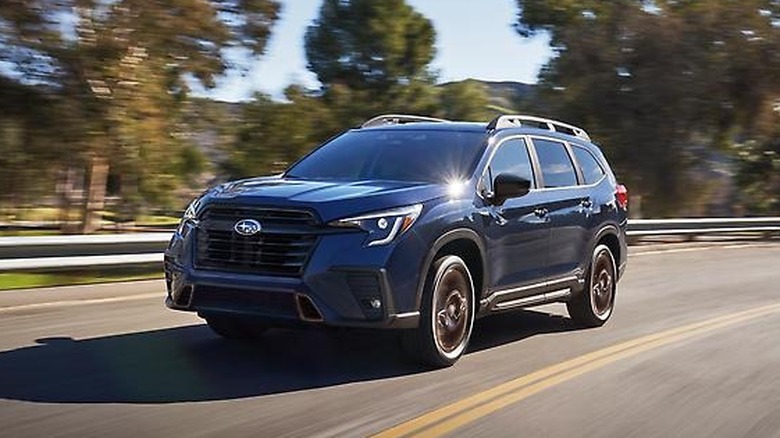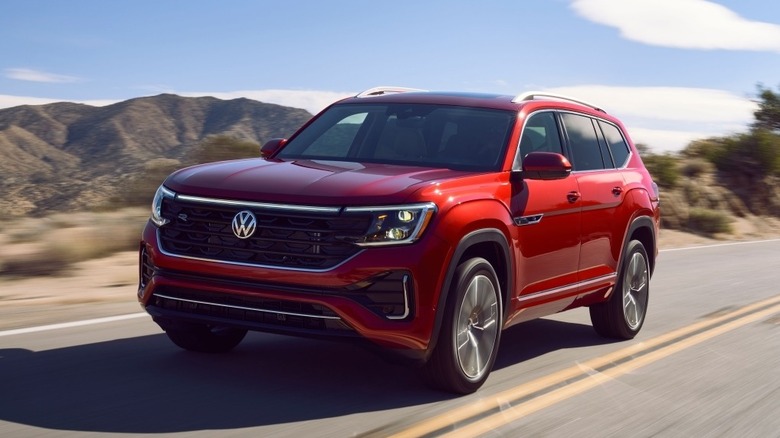Volkswagen Atlas Vs. Subaru Ascent: Which Is Bigger? (And Other Differences, Explained)
If you're looking for a spacious three-row family SUV, you have an abundance of options. There are several vehicles in this class that offer comfortable seating, lots of room for your stuff, and modest all-terrain capability — including the Volkswagen Atlas and Subaru Ascent. They both have enough space for a whole youth basketball team plus gear, but which one is bigger and how else do they differ? From nose to tail, the 2025 Volkswagen Atlas measures 200.7 inches long, while the 2025 Subaru Ascent is slightly shorter at 196.8 inches. Width is similarly close, with the Atlas measuring 78.3 inches wide and the Ascent measuring 76 inches wide. These differences are small, but every little bit matters when you're trying to maneuver or park in crowded city settings.
The two mid-sized SUVs also have similar interior dimensions (legroom and headroom are almost identical) and pricing. If you're looking to find an edge, there's not a lot of separation between the two models, but they do have some differences worth noting. The Subaru, for instance, is one of the focused on off-roading, with 8.7 inches of ground clearance compared to the Atlas' 6.3 inches of clearance. In our review of the Atlas, we found the build quality to be top-notch and seating comfortable in all three rows. The Atlas also offers 20.6 cubic feet of cargo space compared to 17.6 cubic feet for the Ascent. Even though they're closely matched, these are the sorts of small differences that can make one or the other the right car for your needs.
The Subaru Ascent is slightly more expensive than the Volkswaagen Atlas
Both the Atlas and the Ascent offer an array of trim levels with plenty of modern features, but Volkswagen's model is a little more affordable than Subaru's. The base model VW Atlas SE has a starting price of $39,625 (including $1,425 destination fee). It comes standard with front-wheel drive, a 12-inch center touchscreen, and heated and ventilated front seats.Spending a little more gets you extras like all-wheel drive, heated second-row seats, massaging front seats, and leather upholstery. The top Atlas trim is the Premium R-Line and it has an MSRP of $53,205. That's a significant increase over the base model, but the amount of high-end equipment included is pretty appealing.
The base trim for the Ascent is called the Premium and it has an MSRP of $41,415 (including $1,420 destination fee). All-wheel drive is standard, so the Subaru's higher base price is justifiable to most buyers in four-season climates. The Ascent gets heated seats (no ventilation on lower trims here), an 11.6-inch center touchscreen, and tri-zone climate control. Upper trim levels add premium interior materials, heated rear seats, and the ventilated seats that are missing on lower-trim models. MSRP for the top-trim Onyx Edition Touring is $53,470, undercutting the VW by the cost of a couple tanks of gas. So, while base Ascent trims cost a bit more, you get all-wheel drive as standard and a robust feature set on top-trim models.
Power output and fuel economy are similar between the Atlas and Ascent
Like the exterior dimensions, the fuel economy and power capabilities of these two SUVs are a close match. According to the EPA, most trims of the Subaru Ascent will return 22 mpg combined (20 city/26 highway), while upper trims like the Onyx, Touring, and Limited deliver 1 mpg less across the board. EPA estimates for the Atlas range from 20 to 23 mpg combined, depending on trim level and powertrain options. The Atlas uses a turbocharged 2.0-liter four-cylinder engine that produces 269 horsepower and 273 lb-ft of torque, and the Ascent uses a turbocharged 2.4-liter boxer four making 260 hp and 277 lb-ft — it's hard to get much closer than that.
During full-throttle acceleration testing, Car and Driver was able to get the Ascent to go from 0-60 mph in 6.8 seconds; a reasonably quick time for a three-row family SUV. When Car and Driver tested an Atlas, however, it was just a half-second behind at 7.3 clicks. That time difference is relatively small, and will be barely noticeable in real-world driving. If you're interested in pulling a boat or RV, the the Subaru Ascent's 5,000-pound max towing capacity matches up exactly to that of the Volkswagen Atlas. With the Ascent, however, that towing capability is available on every trim level while the base-level Atlas SE trim can only tow 2,000 pounds. With either SUV, it's recommended that you use a trailer brake controller for larger loads. Many states require such systems when towing loads over 3,000 pounds, but check the laws in your area. Subaru recommends using trailer brakes and a controller if you're towing more than 1,000 pounds with the Ascent, and it's always best to err on the side of caution when pulling a trailer.


